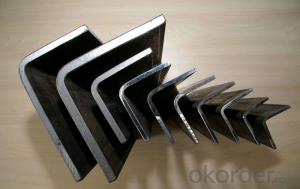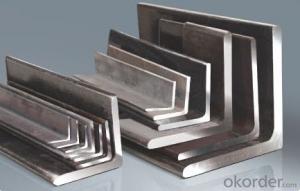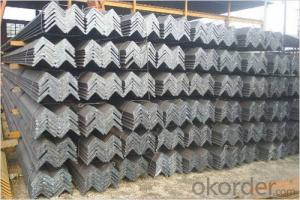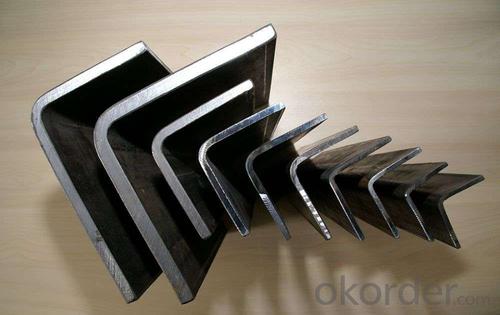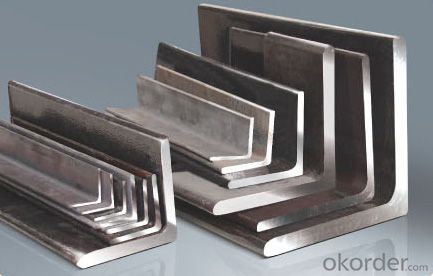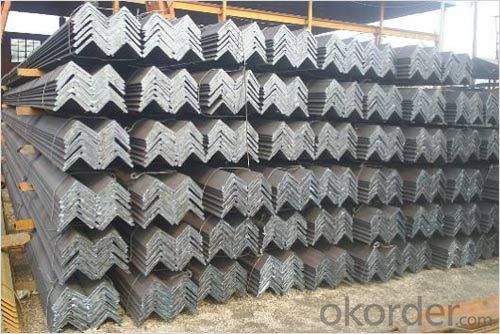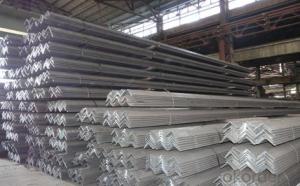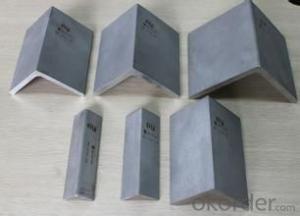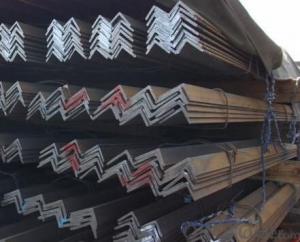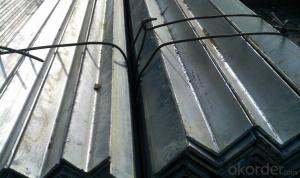GB Equal Unequal Angle Steel, Stainless Steel Angle, Steel Angle Iron Weights
- Loading Port:
- Tianjin
- Payment Terms:
- TT or LC
- Min Order Qty:
- 27 m.t.
- Supply Capability:
- 24000 m.t./month
OKorder Service Pledge
Quality Product, Order Online Tracking, Timely Delivery
OKorder Financial Service
Credit Rating, Credit Services, Credit Purchasing
You Might Also Like
Product Specifications of GB Equal Unequal Angle Steel, Stainless Steel Angle, Steel Angle Iron Weights
GB unequal angle steel
unequal angle steel
material:Q235 Q345
size: 20*3-200*24 or 25*16-200*125(mm)
stainless unequal angle
Detail Information of GB Equal Unequal Angle Steel, Stainless Steel Angle, Steel Angle Iron Weights
1)Tolerance: +/-5% (thickness,length,weight)
2)Certification: Mill Certification
3)Price term: FOB or CFR according to clients requirements
4))Use:shipbuilding,steel tower,construction,electric utility industry
A:Unequal angle bars:25*16*3--200*125*18(mm)
B:Equal angle bars
| Equal angle steel | |||||||
| Size | Width (mm | Thicknessmm) | Density (kg/m) | Size | Width (mm | Thicknessmm) | Density (kg/m) |
| 20 | 20 | 3 | 0.889 | 80 | 80 | 7 | 8.525 |
| 20 | 20 | 4 | 1.145 | 80 | 80 | 8 | 9.658 |
| 25 | 25 | 3 | 1.124 | 80 | 80 | 10 | 11.874 |
| 25 | 25 | 4 | 1.459 | 90 | 90 | 6 | 8.35 |
| 30 | 30 | 3 | 1.373 | 90 | 90 | 7 | 9.656 |
| 30 | 30 | 4 | 1.786 | 90 | 90 | 8 | 10.946 |
| 35 | 35 | 3 | 1.578 | 90 | 90 | 10 | 13.476 |
| 35 | 35 | 4 | 2.072 | 90 | 90 | 12 | 15.94 |
| 35 | 35 | 5 | 2.551 | 100 | 100 | 6 | 9.366 |
| 40 | 40 | 3 | 1.852 | 100 | 100 | 7 | 10.83 |
| 40 | 40 | 4 | 2.422 | 100 | 100 | 8 | 10.276 |
| 40 | 40 | 5 | 1.976 | 100 | 100 | 10 | 15.12 |
| 44 | 44 | 3 | 2.002 | 100 | 100 | 12 | 17.898 |
| 44 | 44 | 4 | 2.638 | 100 | 100 | 14 | 20.611 |
| 38 | 38 | 3 | 1.719 | 100 | 100 | 16 | 23.257 |
| 38 | 38 | 4 | 2.261 | 110 | 110 | 7 | 11.928 |
| 48 | 48 | 3 | 2.19 | 110 | 110 | 8 | 13.532 |
| 48 | 48 | 4 | 2.889 | 110 | 110 | 10 | 16.69 |
| 48 | 48 | 5 | 3.572 | 110 | 110 | 12 | 19.782 |
| 50 | 50 | 3 | 2.332 | 110 | 110 | 14 | 22.809 |
| 50 | 50 | 4 | 3.059 | 125 | 125 | 8 | 15.504 |
| 50 | 50 | 5 | 3.77 | 125 | 125 | 10 | 19.133 |
| 50 | 50 | 6 | 4.465 | 125 | 125 | 12 | 22.692 |
| 56 | 56 | 3 | 2.624 | 125 | 125 | 14 | 26.193 |
| 56 | 56 | 4 | 3.446 | 140 | 140 | 10 | 21.488 |
| 56 | 56 | 5 | 4.251 | 140 | 140 | 12 | 25.522 |
| 56 | 56 | 6 | 6.568 | 140 | 140 | 14 | 29.49 |
| 63 | 63 | 4 | 3.907 | 140 | 140 | 16 | 33.393 |
| 63 | 63 | 5 | 4.822 | 160 | 160 | 10 | 24.724 |
| 63 | 63 | 6 | 5.721 | 160 | 160 | 12 | 29.391 |
| 63 | 63 | 8 | 7.469 | 160 | 160 | 14 | 33.987 |
| 63 | 63 | 10 | 9.151 | 160 | 160 | 16 | 38.518 |
| 70 | 70 | 4 | 4.372 | 180 | 180 | 12 | 33.159 |
| 70 | 70 | 5 | 5.397 | 180 | 180 | 14 | 35.383 |
| 70 | 70 | 6 | 6.406 | 180 | 180 | 16 | 43.452 |
| 70 | 70 | 7 | 7.398 | 180 | 180 | 18 | 48.634 |
| 70 | 70 | 8 | 8.373 | 200 | 200 | 14 | 42.894 |
| 75 | 75 | 5 | 5.818 | 200 | 200 | 16 | 48.56 |
| 75 | 75 | 6 | 6.905 | 200 | 200 | 18 | 54.501 |
| 75 | 75 | 7 | 7.976 | 200 | 200 | 20 | 60.056 |
| 75 | 75 | 8 | 9.03 | 200 | 200 | 22 | 71.168 |
| 75 | 75 | 10 | 11.089 | Length=6-12meters SS400 or Q235 | |||
| 80 | 80 | 5 | 6.211 | ||||
| 80 | 80 | 6 | 7.376 | ||||
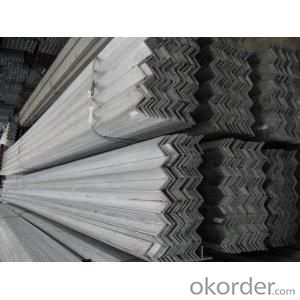
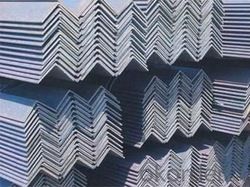
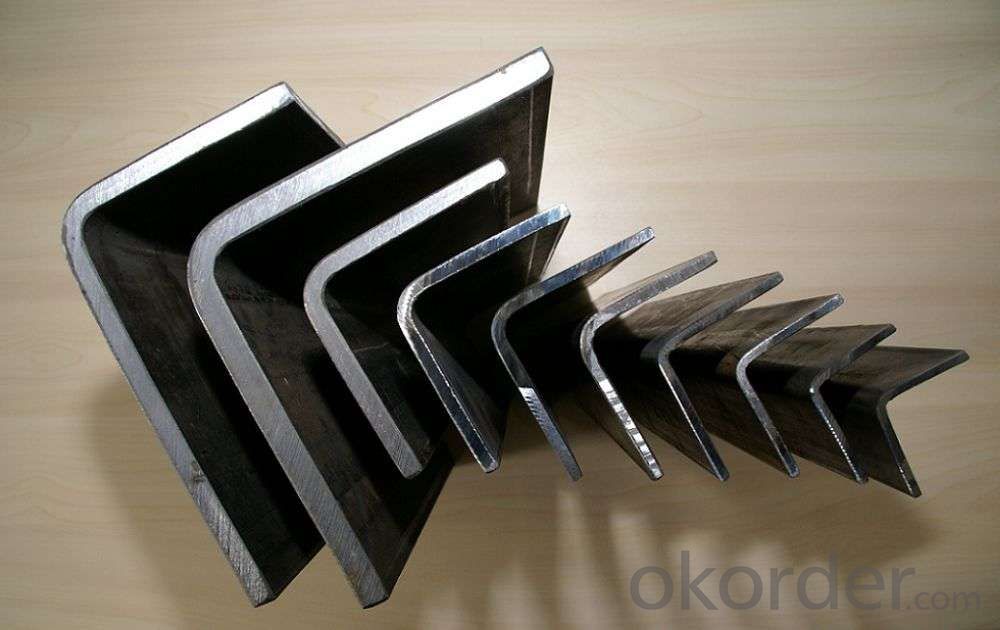
- Q: How do steel angles perform under seismic loads?
- Steel angles perform well under seismic loads due to their inherent structural properties. The L-shape of steel angles provides excellent resistance to bending and torsion forces, making them ideal for withstanding the lateral forces generated during earthquakes. Additionally, their high strength-to-weight ratio and ductility allow them to absorb and dissipate seismic energy effectively, minimizing the potential for structural failure and ensuring the safety of the building.
- Q: What are the considerations for selecting the appropriate steel angle finish?
- Several factors need to be taken into account when choosing the right steel angle finish. Firstly, the intended use or application of the steel angle is a primary consideration. Different finishes offer varying levels of corrosion resistance, which is crucial in environments with moisture or chemicals. For outdoor applications or high humidity environments, a hot-dip galvanized finish is often preferred due to its excellent corrosion resistance. Conversely, a plain steel finish may suffice for indoor applications where corrosion resistance is not a major concern. The desired aesthetic appearance is another consideration. Steel angles can be finished in different ways to achieve various looks. A mill finish provides a raw, industrial appearance, while a powder coat finish offers a polished look and a wide range of color options. The choice of finish depends on the desired aesthetic effect and the overall project design. Durability is also an important factor to consider. Finishes like zinc plating or stainless steel offer enhanced durability and resistance to wear and tear, making them suitable for heavy-duty applications or high-traffic areas. On the other hand, a painted finish may be more prone to chipping or scratching, making it less suitable for long-term durability requirements. Lastly, cost plays a significant role in the decision-making process. Different finishes have varying costs associated with them, so it is necessary to balance the desired finish with the available budget. It is worth noting that while certain finishes may have a higher upfront cost, they may provide long-term cost savings by reducing maintenance or replacement needs. To summarize, the appropriate steel angle finish selection depends on factors such as corrosion resistance, aesthetic appearance, durability requirements, and budget considerations. By carefully evaluating these factors, one can choose the most suitable finish that meets both functional and aesthetic needs.
- Q: What is the typical yield stress of steel angles?
- The typical yield stress of steel angles can vary depending on the specific grade and thickness of the angle, but it generally falls within the range of 36,000 to 50,000 pounds per square inch (psi).
- Q: Can steel angles be used for framing applications?
- Yes, steel angles can be used for framing applications. Steel angles are commonly used in construction and framing due to their durability and strength. They provide structural support and stability when building walls, floors, and roofs. Steel angles are versatile and can be easily welded, bolted, or screwed together to create a strong and stable frame. They are available in various sizes and thicknesses to accommodate different framing requirements. Overall, steel angles are a popular choice for framing applications due to their strength, durability, and ease of use.
- Q: What are the common surface finishes for steel angles?
- There are several common surface finishes for steel angles, each serving a specific purpose and providing different aesthetic appeal. The most common surface finishes for steel angles include: 1. Hot-dip galvanizing: This process involves coating the steel angle with a layer of zinc, which provides excellent corrosion resistance. It is commonly used in outdoor applications where the steel angle is exposed to harsh environments or moisture. 2. Powder coating: Powder coating involves applying a dry powder to the steel angle and then curing it with heat. This finish provides a durable and attractive coating that is resistant to chipping, scratching, and fading. Powder coating is available in a wide range of colors and textures, allowing for customization. 3. Painting: Painting is a versatile surface finish option for steel angles. It can be done using various types of paint, such as epoxy, enamel, or acrylic, depending on the desired level of durability and aesthetic appeal. Painting provides protection against corrosion and can be easily customized with different colors. 4. Mill finish: This is the most basic surface finish for steel angles. It refers to the untreated surface that comes straight from the mill after manufacturing. Mill finish steel angles have a dark, rough appearance and are susceptible to corrosion. They are often used in applications where appearance is not a significant factor or when the steel angle will receive a subsequent surface treatment. 5. Stainless steel finish: Stainless steel angles have a natural resistance to corrosion due to their high chromium content. The surface of stainless steel angles can be left untreated, giving them a clean, sleek appearance. Alternatively, they can be polished to a mirror-like finish, providing a more decorative and attractive look. It is important to consider the intended use, environment, and desired appearance when choosing the appropriate surface finish for steel angles.
- Q: How do you clean steel angles?
- To clean steel angles, you can start by removing any loose dirt or debris with a soft brush or cloth. Then, mix a solution of mild detergent and warm water and use a sponge or cloth to gently scrub the surface. Rinse the angles thoroughly with clean water and dry them with a clean cloth to prevent any water spots or rusting.
- Q: How do you store steel angles to prevent damage?
- To store steel angles and prevent damage, it is important to follow some best practices. Firstly, ensure that the storage area is clean, dry, and free from any sources of moisture or humidity. Moisture can lead to corrosion and rusting of the angles, causing damage over time. It is recommended to store steel angles indoors, in a well-ventilated area, away from direct sunlight or extreme temperature fluctuations. This will help minimize the risk of any potential damage caused by exposure to the elements. When stacking steel angles, it is crucial to use proper supports or racks to prevent them from bending or warping under their own weight. Avoid stacking them too high, as it can cause instability and potential accidents. Using pallets or other suitable storage systems can help maintain the integrity of the angles and reduce the risk of damage. Moreover, it is advisable to separate different sizes and types of steel angles to prevent scratching, chipping, or other physical damage. Placing protective material, such as plastic or rubber mats, between layers or individual angles can offer an additional layer of protection. Regular inspections of the storage area are critical to identify any signs of damage, such as rust spots or deformation, early on. In case of any issues, it is essential to address them promptly to prevent further deterioration and ensure the quality of the steel angles.
- Q: What are the different testing methods for steel angles?
- There are several testing methods for steel angles, including visual inspection, dimensional measurement, hardness testing, chemical analysis, and mechanical testing. Visual inspection involves examining the angles for any visual defects or irregularities. Dimensional measurement ensures that the angles meet the specified size and shape requirements. Hardness testing determines the hardness of the steel, which is an important factor in its strength and durability. Chemical analysis is performed to check the composition and purity of the steel, ensuring that it meets the required standards. Mechanical testing involves subjecting the steel angles to various loads and stresses to evaluate their mechanical properties such as strength and ductility.
- Q: What is the maximum deflection allowed for steel angles?
- The maximum deflection allowed for steel angles depends on several factors such as the specific application, the load applied, and the design standards being followed. Generally, the maximum deflection for steel angles is determined by considering the acceptable level of aesthetic appearance and structural performance. Consulting the relevant design codes or consulting with a structural engineer would provide more specific information on the maximum allowable deflection for steel angles in a given situation.
- Q: What are the different types of corrosion that can affect steel angles?
- There are several different types of corrosion that can affect steel angles, including general corrosion, pitting corrosion, crevice corrosion, galvanic corrosion, and stress corrosion cracking.
Send your message to us
GB Equal Unequal Angle Steel, Stainless Steel Angle, Steel Angle Iron Weights
- Loading Port:
- Tianjin
- Payment Terms:
- TT or LC
- Min Order Qty:
- 27 m.t.
- Supply Capability:
- 24000 m.t./month
OKorder Service Pledge
Quality Product, Order Online Tracking, Timely Delivery
OKorder Financial Service
Credit Rating, Credit Services, Credit Purchasing
Similar products
Hot products
Hot Searches
Related keywords
